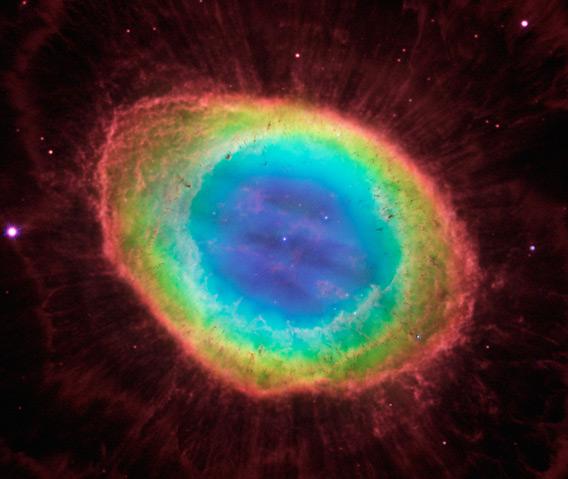The Ring Nebula is one of every amateur astronomer’s favorite objects. From the northern hemisphere it gets up high in the sky in the summer, is ridiculously easy to find, and when you look at it through a small telescope it looks like a ghostly, pale smoke ring.
Of course, when you look at it with Hubble, the picture is significantly more wow-inducing. New observations of the Ring show some amazing details, and have revealed even more information about the dying star that created it.
It’ll also melt your brain.

Photo by NASA, ESA, C.R. O’Dell (Vanderbilt University), and D. Thompson (Large Binocular Telescope Observatory)
Trust me; you really want to click that picture to embiggen it. You’re welcome.
This gigantic gas cloud, ten trillion kilometers across, is the dying gasp of an old star. It probably started out roughly twice the mass of the Sun, and after a few billion years began to run out of hydrogen fuel in its core. The star responded by expanding, cooling (and turning red), and blowing a slow, dense wind of subatomic particles—a stellar wind, like the Sun’s solar wind. Over time, the core of the star underwent various other changes, and the star responded to that by shrinking, heating up, and blowing off a less dense but much faster wind. It lost much of its outer layers to this wind, eventually exposing the hot, dense core (which flooded the gas with ultraviolet light, causing it to glow; that’s why we can see the nebula in the first place).
In rare cases these winds expand as a sphere, but most stars, we’ve learned, possess planets. As the star expands, it can swallow these planets, which act like egg beaters as they orbit inside the star, whipping up the interior and increasing the star’s spin. That in turn changes the shape of the wind, creating fantastic shapes we call planetary nebulae.
In the case of the Ring, it was thought for a long time to be a sphere, but Hubble observations in the late 1990s showed it was actually shaped more like a barrel, and it’s pointed right at us; we’re looking straight down into it. The trick was to look at the blobs of dark material inside the ring; those are where the fast and slow winds meet. If you look carefully, you’ll see they form in a circle at the inside rim. If the Ring were actually a spherical shell, we’d see those blobs scattered across the whole ring, even inside the rim. Since we only see them along that circle, it’s clear we’re looking down the top of a cylinder.
These new observations are even deeper and high-resolution than those older ones, and reveal new structure. You can see radial spokes heading away from the center, just outside the main ring. Those are actually due to shadowing, the light from the central star blocked by the darker, denser blobs. They’re cosmic crepuscular rays!

Photo by Shutterstock/Wiktory
The nebula is filled with a blue glow due to helium gas, and it’s now thought that this hot gas fills the entire interior and sticks out the ends, a bit like a hot dog in a wrap-around bun. The Ring is a pig-in-the-blanket! Of course, it’s one that’s a light year across, to give you a sense of scale. That’s a lot of hot dog.
The Ring is a fantastic and beautiful example of what happens when a star dies, and it happens to be close enough—roughly 2000 light years—that we get a pretty good view of it. And yet, after all this time, it also shows us there’s still much to learn about what happens when a star shuffles off this mortal coil.